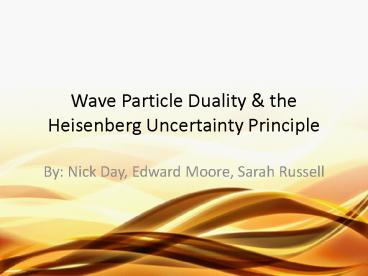Wave Particle Duality - PowerPoint PPT Presentation
1 / 15
Title:
Wave Particle Duality
Description:
Wave Particle Duality & the Heisenberg Uncertainty Principle By: Nick Day, Edward Moore, Sarah Russell Wave particle duality (WPD) Both matter and electromagnetic ... – PowerPoint PPT presentation
Number of Views:309
Avg rating:3.0/5.0
Title: Wave Particle Duality
1
Wave Particle Duality the Heisenberg
Uncertainty Principle
- By Nick Day, Edward Moore, Sarah Russell
2
Wave particle duality (WPD)
- Both matter and electromagnetic radiation
exhibit some properties of waves and some
properties of particles. (McGraw-Hill) - Matter sometimes acts like a wave, sometimes like
a particle, depending on the experiment. - Early development of quantum theory
3
http//woodahl.physics.iupui.edu/Astro105/OLDindex
.html
4
- Matter has dual nature duality
- Experiments show light seems to go only in a
straight line particle nature. Experiments show
that light has frequency and wavelength wave
nature. - 1909, Geoffrey Taylor double-slit experiment
light is a wave. Special camera tool photos of
the light exiting he experiment tiny pinpoints
of light, light is a particle.
5
(No Transcript)
6
(No Transcript)
7
Heisenberg Uncertainty Principle (HUP)
- The position and momentum of a particle cannot
simultaneously measured with arbitrarily high
position. (Hyperphysics) - Particles momentum position cannot both be
known at the same time. - Result of wave particle duality
8
photon
A particle can be seen only by scattering light
off it. The scattering changes the electron
momentum.
9
http//www.google.ca/imgres?qheisenberguncertain
typrinciplehlenbiw1326bih586gbv2tbmisch
tbnidzUOmu4klq9tIBMimgrefurlhttp//www.physic
softheuniverse.com/topics_quantum_uncertainty.html
docidxuIbjvw0aiRKfMimgurlhttp//www.physicsoft
heuniverse.com/images/quantum_microscope.jpgw372
h591eiGsCdT934DOLD0QGD3KCTDwzoom1iacthcvp
x170vpy186dur8313hovh283hovw178tx119ty
243sig108975557308224056383page2tbnh128tbn
w81start21ndsp29ved1t429,r0,s21,i116
10
- If particle momentum is measured, position will
be changed. - Bonus If energy of the particle is known, we
cannot know length of time it has that energy
(vise versa). - Example http//science.howstuffworks.com/innovati
on/science-questions/quantum-suicide2.htm
11
- Star Trek Transporter Beams Take a person apart
molecule by molecule, kept organized, reassembled
elsewhere. HUP impossible to identify individual
particles and keep track of them.
http//www.coolest-gadgets.com/20070607/beam-me-up
-scotty-scientists-make-breakthrough-with-trek-tra
nsporter-theory/
http//realityviews.blogspot.ca/2011/04/quantum-te
leportation-successful.html
12
http//www.youtube.com/watch?vH-AlfuvjPYM
13
Homework
- 1. The HUP states that a particle's _______ and
- ______ cannot both be known at the same time.
2. A particle can be seen only by scattering
light off - of it. The scattering a) changes the size of
the particle b) changes the mass of the
particle c) changes the momentum of the
particle d) all of the above3. What is wave
particle duality?4. Define the Heisenberg
Uncertainty Principle. 5. T/F? Only matter can
have wave-like - characteristics and particle-like
characteristics.
14
Corrections
- 1. position and momentum2. c) changes the
momentum of the particle3. Matter sometimes acts
like a wave, - sometimes like a particle, depending on the
experiment. 4. A particles momentum position
cannot both be known at the same time.5. False,
matter and electromagnetic radiation can have
wave-like characteristics and particle-like
characteristics.
15
Sources
- http//simple.wikipedia.org/wiki/Wave-particle_dua
lity - http//hyperphysics.phy-astr.gsu.edu/hbase/uncer.h
tml - http//www.aip.org/history/heisenberg/p08.htm
- McGraw-Hill textbook
- Physics Principles and Problems textbook
- Physics Concepts and Connections textbook

